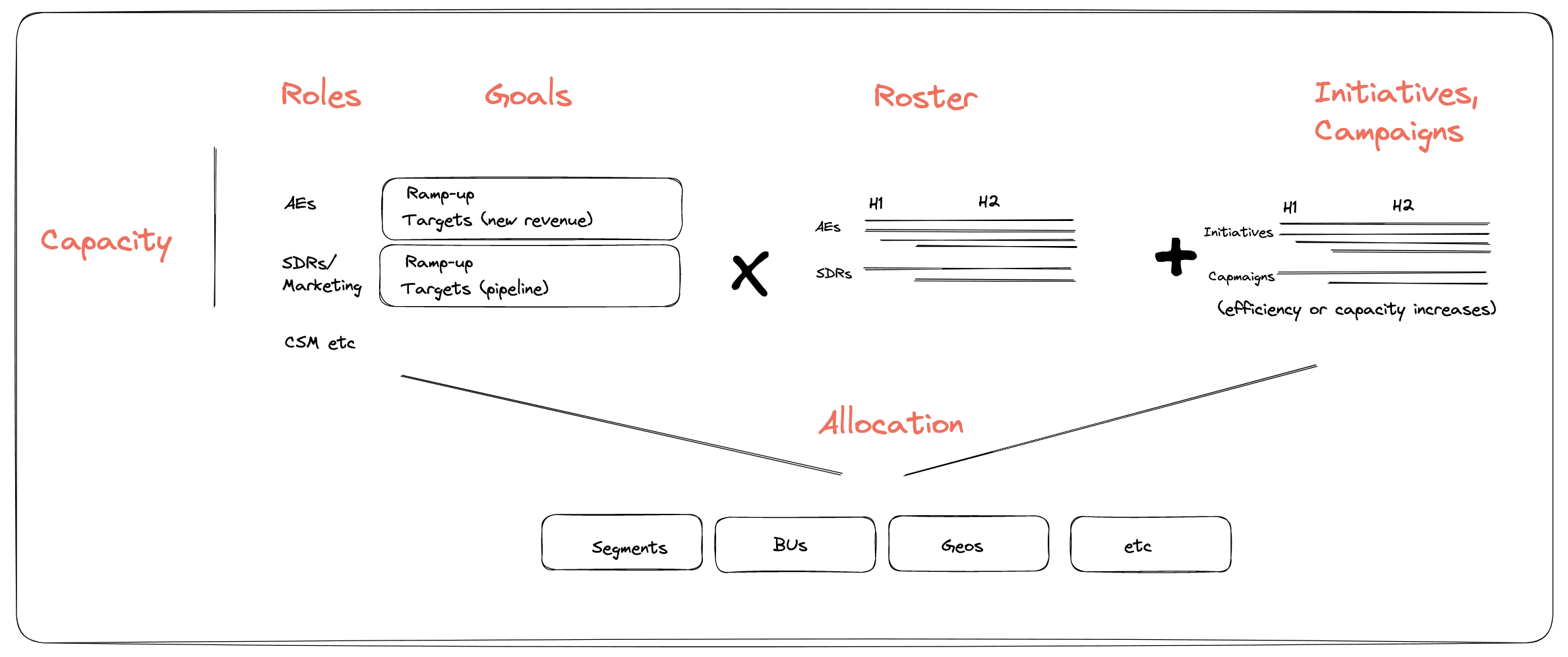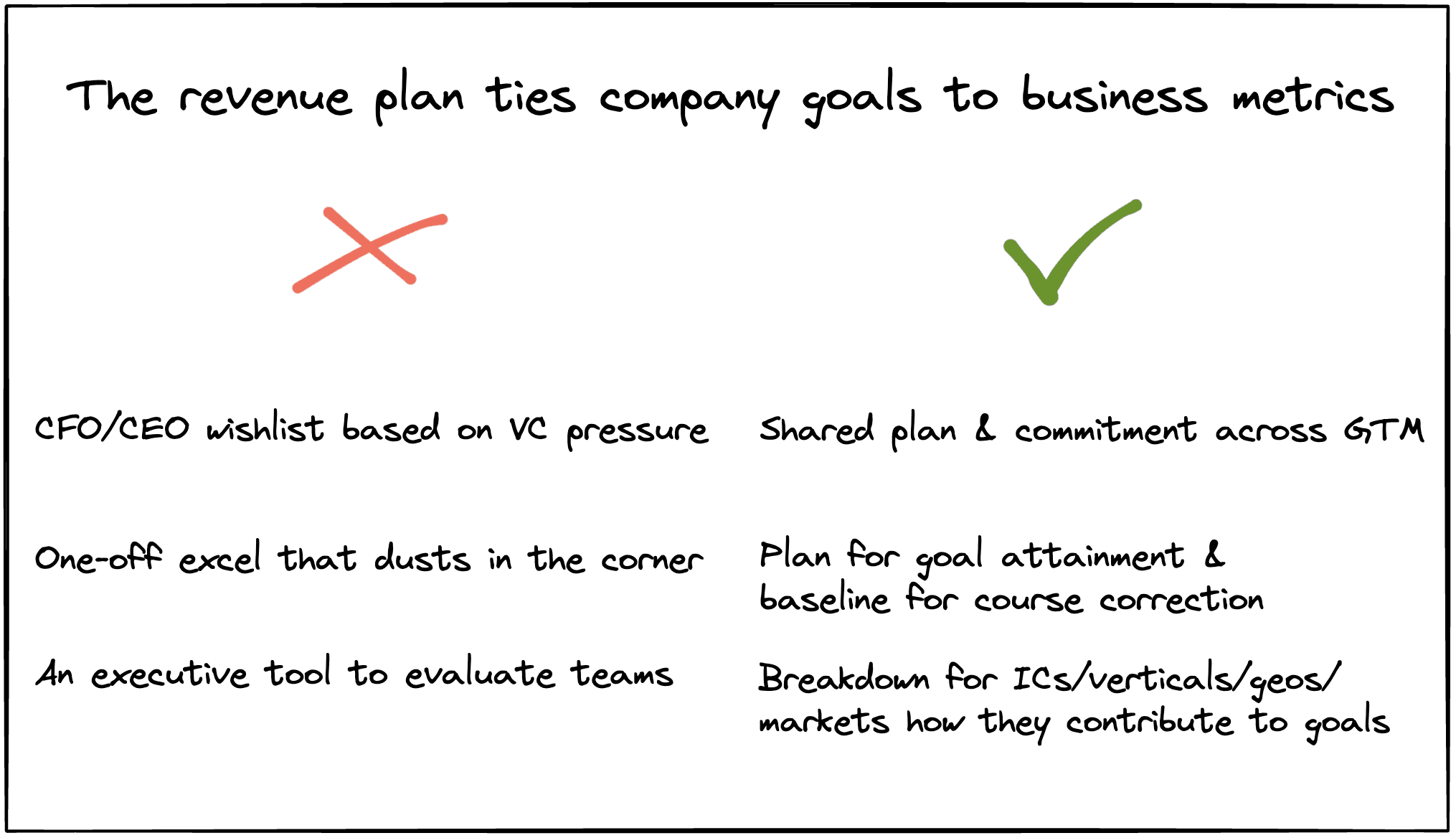Reaching your revenue targets in SaaS is tough, now more than ever. There’s a lot of complexity to account for everything that’s going on in your go-to-market teams.
In my experience, the #1 reason why companies miss their target is not because of changing market conditions, but because of bad revenue planning and execution.
Why is it so difficult to plan your revenue correctly?
Usually, the CEO, CFO, or even investors plan the annual revenue goals top-down based on internal benchmarks (usually hitting 2-3x annual growth after Series A). Most of the times, they are too far away from knowing whether those can actually be achieved, as they lack insights into the reality of your revenue teams & execution power.
Meaning, their $X million ARR goal will very probably fail and GTM teams don’t know what type of truck hit them when they see the plans.
Two approaches to revenue planning
Starting with top-down planning is still the industry standard, even though some brave organisations are turning this around these days. Starting with top-down is fine, as long as your CRO/VP RevOps can challenge the assumptions and match it with a granular bottom-up plan to close the gap between them. This is a step that’s too often missed though.

Bottom-up revenue planning done right is an immense stakeholder negotiation process. It creates buy-in, so your plans become more than nice excel sheets to muse about from time to time. To increase the predictive power of planning, it’s also important to create different scenarios for your plans. So you have e.g. a conservative, an optimistic and a best-case revenue plan to pull out. Based on those, it’s useful to negotiate budgets & resources and challenge assumptions to adapt the plans.
How to create a realistic bottom-up plan
Let’s take a step back: The revenue plan is the baseline for goal achievement and course correction for your company, and in specific for all your revenue-generating teams.
If you’re doing this right, it’s a spreadsheet that ties your business goal to operational metrics in the right granularity and in a bottom-up manner. That means, you know exactly which revenue target you plan for which channels (inbound vs outbound vs PLG), products, geographies, and customer segments - and yes, this is a matrix, which makes it complex. Plan in both volume metrics as well as $ revenue.
How you get to a realistic bottom-up plan: Calculate your capacity first (roles and their ramp-up and pipeline goals * commercial roster and add your projects that increase efficiency or capacity) and allocate it to your dimensions.

Most common pitfalls I’ve seen in revenue planning
Avoid the following:
Basing revenue goals on last years’ revenue, and randomly tripling or quadrupling with no one actually knowing the reason or how the company will get there
CEO & VC pressure on the goal but no detailed plan for all dimensions
Closing gaps in your top-down plan with AE quotas (”We are missing €1 mio, so let’s just add 2 AEs with €500k quota each”)
Too vague or intransparent assumptions (sudden crazy jumps in CVRs, ACVs, quotas etc.)
Unequal distribution of goals between quarters (slow Q1 & push >40% of ARR goal into Q4)
Using too many blended averages, e.g. using the same CVR, cycle time, and ACV assumptions for inbound and outbound (inbound is faster, has higher conversions, and usually smaller ACVs)
Forget to include everything important for your revenue engine: budget, current roles, hiring plan & projects with expected revenue impact
Not adapting your plan throughout the year and reviewing your performance against goal constantly (ideally weekly!)
As a CEO, make sure your revenue plan is not a wishlist and a one-off excel, but that you operationalize it with the help of your RevOps team. This starts with making the plan in the right granularity in the first place and basing your goals on assumptions.

Best-practices on operationalizing the revenue plan
Once you have the granularity which you also use for tracking your revenue, and included all dimensions to your business model (channels, products, geographies, and customer segments) as well as dimensions for operationalizing (budgets, hiring plans, projects) - the first step is done!
After checking your assumptions with RevOps, reveal the plan (if you haven’t collected realistic assumptions from all teams beforehand!). Make sure to over-communicate the revenue plan to your go-to-market teams in a joint meeting and over time. Assign owners - everyone should know exactly for which goals they are responsible and/or working towards.
To make sure your revenue plan doesn’t dust in the corner, establish a strict operating cadence, ideally with weekly meetings, MBRs and QBRs to review performance against plan. In these meetings, every owner of a goal should review a ready-made report managed by RevOps so that any slippery slope gets flagged immediately and counteractions can be defined.
Further good practices include:
Connect goals and metrics to OKRs
Establish a rigorous sales process to get accurate metrics (or really embrace flying blind)
Map your customer journey across departments and tie it to goals and metrics
Enable adjusted and continuous capacity management (e.g. to close lead supply gaps because of sick SDRs)
Create ICP clarity, review your ICP adherence (existing and new customers), and sharpen your ICP definitions regularly during your QBRs
If you have questions regarding your revenue plan and want me to help you improve it, reach out to me via LinkedIn!